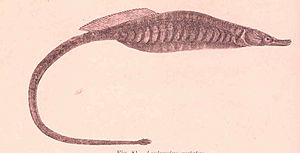Kaupus costatus facts for kids
Quick facts for kids Kaupus costatus |
|
|---|---|
 |
|
| Conservation status | |
| Scientific classification | |
| Synonyms | |
|
Leptonotus costatus Waite & Hale, 1921 |
The deepbody pipefish (Kaupus costatus) is a special type of pipefish. It lives only in Australia, mainly along its southern coast. This fish can grow to about 12.9 centimeters (around 5 inches) long. It's the only known species in its group, called Kaupus. This group was named after a scientist who studied fish, Johann Jakob Kaup.
Contents
What the Deepbody Pipefish Looks Like
The deepbody pipefish has a very long, thin body. Adult females have a body that is flatter from side to side and much deeper than the males' bodies. Its head is straight with its body. The snout (its nose area) is a medium length, taking up about one-third to almost half of the head's length.
It has ridges along its snout and above its eyes. The ridges on its cheek plates (called opercules) are straight. The ridges along its body break near its back fin. Its tail is not used for grabbing things.
Fins and Colors
The deepbody pipefish has several fins:
- The dorsal fin (on its back) is closer to its head than its tail. It has a medium-long base.
- The anal fin (on its belly, near the tail) is very small.
- The caudal fin (its tail fin) is small and round.
- The pectoral fin (on its sides, like arms) is also present.
This fish usually has 30 to 36 soft rays in its dorsal fin, 3 to 4 in its anal fin, 9 to 11 in its pectoral fin, and 7 to 10 (usually 9 or 10) in its caudal fin. Its body has 16 to 18 rings on its main part and 35 to 38 rings on its tail.
The deepbody pipefish is often red or reddish-brown. It has tiny blue, yellow, or white spots on its back. It also has wavy, thin marks of the same colors on its head and tail. Adult males and younger fish sometimes have a thin, dark stripe along the middle of their tail near the body. Adult females have bluish streaks, lines, and small spots above their side ridge. They also have a clear blue patch on each body ring below this ridge.
Where the Deepbody Pipefish Lives
The deepbody pipefish lives only in the ocean waters along the southern coast of Australia. You can find it in the states of Victoria and South Australia, as well as near Tasmania, in the Bass Strait, and in the Great Australian Bight.
Habitat and Life Cycle
Deepbody pipefish live among seagrass and algae beds. They can also be found in mangrove areas and estuaries (where rivers meet the sea). They live at depths from the surface down to about 50 meters (164 feet). They prefer muddy areas, but the water needs to be fairly clear.
Diet and Reproduction
We don't know much about what they eat. However, like other Australian pipefish, they probably eat small plankton (tiny floating creatures) and possibly small crustaceans that live on the seafloor.
The deepbody pipefish has a special way of having babies. The males carry the fertilized eggs under their tail. This is called being ovoviviparous. After the eggs hatch inside the male, he gives birth to live, tiny fish, called fry. The number of babies in each group is quite small, usually between 3 and 25 eggs. When the babies first hatch, they are about 15 millimeters (0.6 inches) long.
Protecting the Deepbody Pipefish
The deepbody pipefish is listed as a protected marine species in Australia. This means it's protected by the Environment Protection and Biodiversity Conservation Act 1999. It's also protected in all the states where it lives by local fishing laws.
This fish likes to live in healthy, undisturbed seagrass beds, especially those with Zostera seagrass. If these seagrass beds shrink or disappear, it becomes a threat to the deepbody pipefish. Protecting these habitats is important for the fish to survive.
See also
 In Spanish: Kaupus costatus para niños
In Spanish: Kaupus costatus para niños


